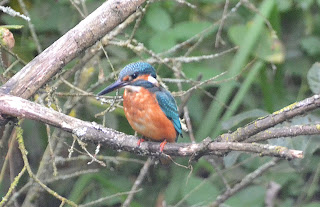Paxton – Far from the Pits (But Close to Home)
On Tuesday
last, I paid a visit to Paxton Pits, a reserve I was keen to see for a number
of reasons, not least of which, was because in many ways, it is similar to our
own reserve at HESC.
Paxton Pits
can be found about 2 miles north of St
Neots, just off the A1 and thanks to the
new A421, can be reached from MK in not much over 35 minutes.
Like HESC
Paxton has evolved out of old gravel workings, but at around 190 acres it is
nearly double the size. Paxton is also much younger than HESC, having been
officially opened as a Local Nature Reserve (LNR) in 1989. Parts of the site are still being worked and
are currently closed to the public, however, when these workings are phased out
over the next ten years, they too will be incorporated into the LNR which will
make the site nearly 700 acres in size.
The reserve
like HESC consists of a mixture of lakes and meadows, bordered on the east by
the river Great Ouse. The lakes and meadows are larger than those at HESC and
overall it feels a lot less wooded and more open than the MK site.
Many of the
species of birds, mammals, reptiles and
insects are also similar to those we get at the Hanson Centre, although Paxton
has the attraction of Nightingales for the birders (Turtle Dove were also
present when I visited) and for the Dragonfly enthusiast the site holds the
rare Norfolk Hawker.
At the time
of my visit the lakes held good numbers of Common Tern, interspersed with B H
Gulls and a fair few Cormorants. There were also quite a few rafts of Tufted
Duck on the water. The Kingfisher hide failed to live up to it’s name but I was
reliable informed by the locals that not only Kingfisher but also Otter can be
regularly spotted from this viewing point.
Common Tern Whizzing Past The Kingfisher Hide
After spending
some time exploring the lakes and following the Heron Trail, which is about 2
miles long, I back-tracked to the Visitor Centre, to explore the Meadows Trail
(1.5 miles), where I was told my best chances of encountering the elusive
Norfolk Hawker lay. Although the meadows did hold quite a few Dragonflies, I
was unable to identify the invader from the east. During my search I did manage
a close encounter with a Four-spotted Chaser munching a large black bug and
then came across a Common Spotted Orchid growing by the side of the pathway.
Common Spotted Orchid
By this time
I was ready for a sit down and a cold drink and so I returned to the Visitors
Centre and enjoyed a long chat with Jim Stevenson the full time Ranger and two
of the volunteer wardens from the friends group. I was particularly interested
to learn how the reserve is run and managed.
They explained that Huntingdonshire District Council’s
Countryside Services is responsible for the Reserve, whilst the Ranger manages
the Reserve according to the Management Agreement under the terms of the Local
Nature Reserve (LNR) designation.The Ranger is advised by a Management Group,
which includes local experts, Natural England, landowners within the LNR, The
Friends of Paxton Pits Nature Reserve, the Volunteer Warden Coordinator and the
two Aggregate Companies.
Much of the funding
for projects and help in maintaining the site is provided by the Friends of Paxton
Pits Nature Reserve which has over 2000 members. I was amazed to hear that the
reserve receives around 120,000 visitors a year, although it should be remembered
that in many ways it is a public park, with free entry and allows dog walking
and fishing on some of the smaller lakes.
The FoPPNR volunteer
wardens and rangers staff the Visitors Centre and provide information to
visitors as well as selling light refreshments, a few books, maps, bird seed
and feeders etc.
Four-spotted Chaser taking afternoon tea
(I am told the Scarce Chaser is more common on this reserve!)
I was made extremely
welcome by the people at Paxton and will certainly return soon. For me the visit
was very inspirational and I came away thinking that whilst not all that they
do at PP would be right for HESC, we could certainly learn from many of their
initiatives.












